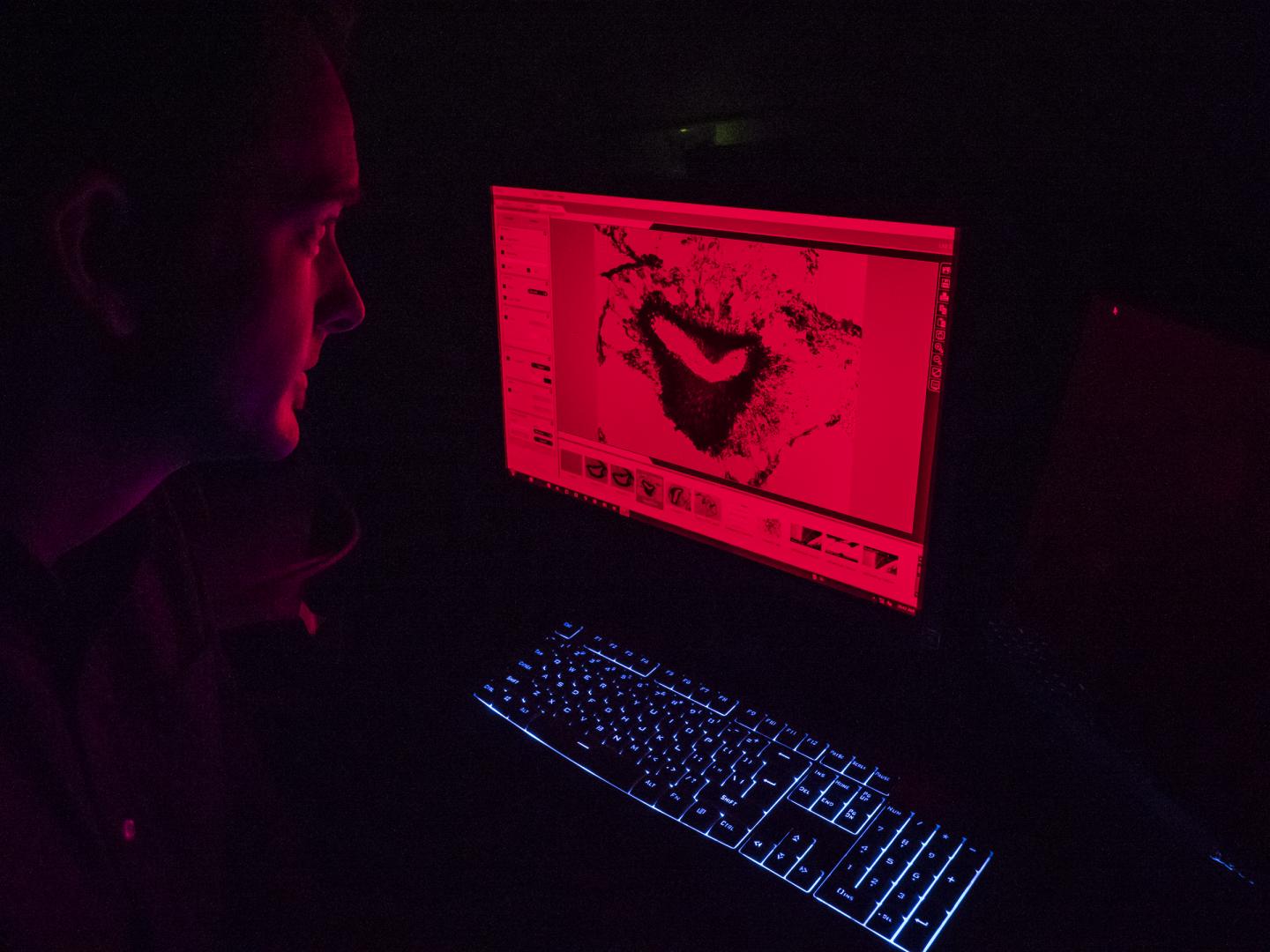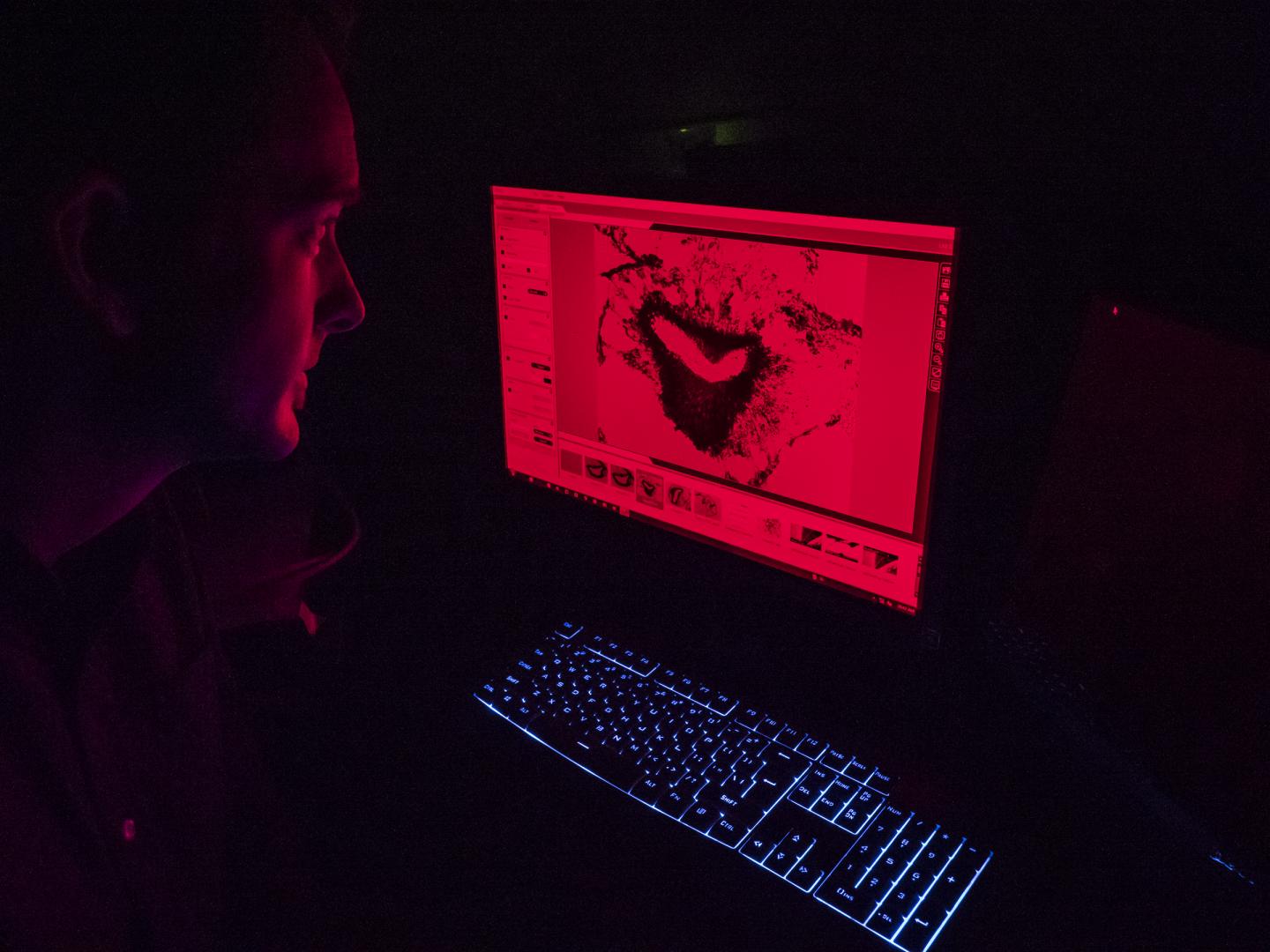
Credit: Jay Yocis/UC Creative Services
Nathan Morehouse is preoccupied with color and the way animals observe it.
The biology professor at the University of Cincinnati will use half of a new $2 million grant from the National Science Foundation to study the vision of jumping spiders around the world.
These furry little spiders are found on six continents — and they're cute, which is a weird thing to say about a spider. With their oversized Disney-character eyes and solicitous postures, they look like fuzzy, attention-seeking puppies.
In his lab, Morehouse has revealed their surprisingly keen color vision. While most spiders can see only a few colors on the spectrum between ultraviolet and green, some jumping spiders can see many others, including reds, oranges and yellows. And they do so in surprising ways.
One has four types of color-sensitive cells in their eyes similar to the cones in our eyes. Another family of jumping spiders uses filters in their retinas to extend their color spectrum. Morehouse suspects a closer inspection will reveal even more interesting ways that spiders can admire the colors of the rainbow.
And they are legion. Morehouse said there are more species of jumping spiders than mammals — more than 5,000 species, some of them waiting to be described by scientists.
Many male jumping spiders sport vivid colors like the feathers of birds to attract mates during courtship rituals. But Morehouse said color vision might provide other benefits, such as finding tasty insects or avoiding toxic ones.
"Why do animals have color vision? What are the benefits and consequences for use of color in foraging and communication?" he asked.
Morehouse will use his half of the grant to take his students into the field from Indonesia to Australia to find out.
"We're really trying to think about global biodiversity," Morehouse said.
By studying the vision of animals such as spiders, scientists are able to engineer better sensors for technology such as self-driving cars, Morehouse said.
"Autonomous vehicles must make sense of an enormous amount of information. How do you give a system the right guidance rules to avoid a pedestrian?" Morehouse wonders. "Spiders have eight eyes but a brain the size of a poppy seed. They may have a lot to teach us about how to use simple algorithms for making complex navigational decisions."
Researchers are just beginning to understand the fascinating sensory abilities of spiders.
The other half of the five-year grant will go to UC's research partners at institutions in Vancouver, Canada, as well as in Hawaii and Florida. To get at the question, Morehouse said he will begin with the spider's lineage by sequencing hundreds of species and comparing the results with known examples.
"We'll build the world's best jumping spider family tree," he said. "That's a core mission."
But Morehouse also will bring his lab's considerable technology into the field. Using microspectrophotometry, he and his students can measure how photoreceptor cells in spider retinas absorb light. This tells researchers what colors spiders can see and how.
His lab features several enclosed workstations like darkrooms where researchers can precisely measure light to study spider vision. They will be packing up this equipment and taking it with them on their global journey.
University of Florida researcher Lisa Taylor is collaborating on the study. She plans to examine spider behavior in Florida and Arizona as well as in Australia and India. She and Morehouse worked together on spider vision studies while she was a postdoctoral fellow in Morehouse's lab at the University of Pittsburgh.
"What are the benefits for spiders that have good color vision?" she asked. "And for species that don't have it, how do they find prey or avoid toxic prey?"
Taylor first thought about color while studying unusual birds in Australia. Male bowerbirds build "bowers" or little grass pergolas that serve as an arena for their courtship dances. Many of them adorn their bowers with colorful decorations: flowers, leaves or bright bits of litter that match their preferred color scheme. Some bowerbirds are especially fond of the color blue.
"They are really charismatic birds that decorate their bowers with colorful things," Taylor said.
Her collaboration with Morehouse determined that lab spiders could be trained to have an affinity for or aversion to particular colors. They fed spiders bright-red milkweed bugs. Some bugs were raised on a diet of their namesake milkweed, which makes them toxic to spiders. Others were fed a diet of sunflower, which makes the bugs delicious to spiders.
The lab spiders quickly learned to associate the color red with either noxious or delicious tastes to the point where some would flee unrelated red objects while others would seek them out.
"These spiders make good foraging choices from experience," she said.
Nature filmmaker Day's Edge Productions will accompany UC's researchers to document their journey. The company makes educational features and short films on the environment and public research.
"I've known about the excellent work the Day's Edge crew has been doing for a long time, and am really excited to work with them. They will produce a series of short films with the intention of potentially producing a broadcast-length film," Morehouse said.
Meanwhile, Morehouse said he will work with the Cincinnati Museum Center and other museums affiliated with his partner researchers to develop programming on spider vision.
"We have partner labs in Vancouver, Hawaii and Florida, so we reached out to museums there and they will incorporate the programming, too," Morehouse said.
At UC's Morehouse Lab, students care for myriad North American spiders. One called Habronattus oregonensis has overdeveloped forelegs like the arms of a bodybuilder.
"We affectionately call them Popeye spiders," Morehouse said.
Students capture each spider individually by hand. Jumping spiders are largely diurnal, or active in the day, and live in a variety of habitats. So researchers must have sharp eyes to see them scurrying over rocks or the leaf litter.
Some live in trees, so Morehouse spreads a sheet on the ground under the canopy and bangs on branches with a tire thumper, the heavy baton truckers use to check tire pressure. Arboreal jumping spiders fall from the branches and are scooped up easily enough.
To study their interaction, researchers place them in little white boxes called arenas illuminated with bright lights where they can be filmed in fine detail.
The principal eyes, the biggest ones facing front, feature twin lenses that capture light and provide resolution.
"They work like a Galilean telescope," he said.
Last year, Morehouse weighed in on a late-night Twitter discussion with astronomers Jamie Lomax and Emily Levesque that ended up being recounted in The Atlantic and National Geographic. The astronomers were shining laser pointers on the wall to tease random jumping spiders they found. The arachnids were mildly curious about red laser light but unleashed eight legs of fury trying to catch the moving green dot.
Morehouse tweeted how green could be more triggering to spiders because of their acute color vision in this spectrum. And when pressed about the astronomers' celestial interests, Morehouse calculated that jumping spiders, indeed, have the visual acuity to see the distant moon, if they were so inclined.
When it comes to the world's best color vision, humans and other primates aren't even in contention. Morehouse said the prize goes to a creature that has 16 types of photoreceptor cells compared to our three: the mantis shrimp.
But with its variety of color sensitivities, the humble jumping spider may end up being the best animal to teach us why color vision evolves.
###
Media Contact
Michael Miller
[email protected]
513-556-6757
@UofCincy
http://www.uc.edu/news
Original Source
https://www.uc.edu/news/articles/2018/10/n204046.html





